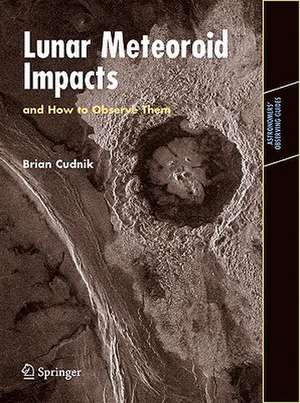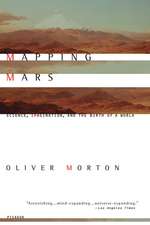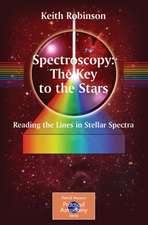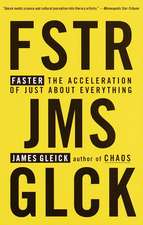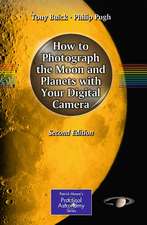Lunar Meteoroid Impacts and How to Observe Them: Astronomers' Observing Guides
Autor Brian Cudniken Limba Engleză Paperback – 4 dec 2009
Din seria Astronomers' Observing Guides
-
 Preț: 183.23 lei
Preț: 183.23 lei -
 Preț: 196.41 lei
Preț: 196.41 lei -
 Preț: 189.37 lei
Preț: 189.37 lei -
 Preț: 193.12 lei
Preț: 193.12 lei -
 Preț: 184.28 lei
Preț: 184.28 lei -
 Preț: 304.58 lei
Preț: 304.58 lei -
 Preț: 273.58 lei
Preț: 273.58 lei -
 Preț: 275.79 lei
Preț: 275.79 lei -
 Preț: 280.19 lei
Preț: 280.19 lei -
 Preț: 251.37 lei
Preț: 251.37 lei -
 Preț: 260.39 lei
Preț: 260.39 lei -
 Preț: 213.79 lei
Preț: 213.79 lei -
 Preț: 254.90 lei
Preț: 254.90 lei -
 Preț: 298.02 lei
Preț: 298.02 lei -
 Preț: 217.51 lei
Preț: 217.51 lei -
 Preț: 300.37 lei
Preț: 300.37 lei -
 Preț: 270.70 lei
Preț: 270.70 lei -
 Preț: 345.09 lei
Preț: 345.09 lei -
 Preț: 342.13 lei
Preț: 342.13 lei -
 Preț: 246.30 lei
Preț: 246.30 lei -
 Preț: 256.78 lei
Preț: 256.78 lei -
 Preț: 210.90 lei
Preț: 210.90 lei
Preț: 254.46 lei
Nou
Puncte Express: 382
Preț estimativ în valută:
48.70€ • 50.55$ • 40.61£
48.70€ • 50.55$ • 40.61£
Carte disponibilă
Livrare economică 01-15 martie
Preluare comenzi: 021 569.72.76
Specificații
ISBN-13: 9781441903235
ISBN-10: 1441903232
Pagini: 256
Ilustrații: XVI, 240 p. 152 illus.
Dimensiuni: 190 x 260 x 18 mm
Greutate: 0.45 kg
Ediția:2009
Editura: Springer
Colecția Springer
Seria Astronomers' Observing Guides
Locul publicării:New York, NY, United States
ISBN-10: 1441903232
Pagini: 256
Ilustrații: XVI, 240 p. 152 illus.
Dimensiuni: 190 x 260 x 18 mm
Greutate: 0.45 kg
Ediția:2009
Editura: Springer
Colecția Springer
Seria Astronomers' Observing Guides
Locul publicării:New York, NY, United States
Public țintă
Popular/generalCuprins
The Moon and Meteoroids.- Widespread Evidence.- Lunar Impact Features.- Remarkable Collisions.- Possible Impact Phenomena (PIPs).- Beyond the Moon.- An Observer’s Guide to Lunar Meteor Impacts, Past and Present.- Guide to Observing Impact Features on the Moon.- Impacts Today.- Lunar Impact Observation Programs.- Observing Impacts as They Happen with Contributions by Many Members of the International Occultation Timing Association.- Finding Collisions.- Spurious Flash or True Impact Event?.- Professional and Amateur Collaboration.
Recenzii
From the reviews:
“Cudnik (Prairie View A&M) … presents a comprehensive observer’s guide written for those who would like to directly participate in this type of research. … This work provides a discussion of the types of impact phenomena seen throughout the solar system, a thoroughly documented set of past observations of probable and confirmed lunar impacts, and very specific recommendations for the types of equipment to use for viewers to make their own observations. … Summing Up: Recommended. All levels/libraries.” (C. Palma, Choice, Vol. 47 (11), August, 2010)
“The successful recording of … lunar meteoroid impacts revived interest amongst a small group of lunar observers in this observing niche and much of this book is spent describing the techniques necessary to record these very rare events. Every piece of hardware and software and every technique the digital or visual observer might want to use, to detect lunar impacts, is covered in the book. … This book is very comprehensive and … lunar observing specialists will feel inclined to add it to their bookshelves.” (Martin Mobberley, Astronomy Now, April, 2011)
“The Moon is subject to the untrammeled force of impact from meteoroids, asteroids and comets … . Brian Cudnik, was first to observe a meteor impact on the Moon in real time. He sets forth a programme for observing impact events based on visual / CCD experiences of a host of historical events, couching it within the guidelines set forth by the ALPO (Association of Lunar and Planetary Observers). Recommended lunar reading!” (Peter Grego, Popular Astronomy, March-April, 2011)
“Providing an historical overview of impact cratering, not only on the Moon but throughout the Solar System … . serve as a practical guide to observing lunar meteoroid impacts and they introduce the serious amateur to a programme of observational work that can truly yield valuable results and allow genuineprofessional-amateur collaboration. … a valuable book on an important observational opportunity for the amateur, and Cudnik is to be congratulated on writing a clear and compelling tutorial on how to go about such work.” (Bill Leatherbarrow, The Observatory, Vol. 131 (1223), August, 2011)
“Cudnik (Prairie View A&M) … presents a comprehensive observer’s guide written for those who would like to directly participate in this type of research. … This work provides a discussion of the types of impact phenomena seen throughout the solar system, a thoroughly documented set of past observations of probable and confirmed lunar impacts, and very specific recommendations for the types of equipment to use for viewers to make their own observations. … Summing Up: Recommended. All levels/libraries.” (C. Palma, Choice, Vol. 47 (11), August, 2010)
“The successful recording of … lunar meteoroid impacts revived interest amongst a small group of lunar observers in this observing niche and much of this book is spent describing the techniques necessary to record these very rare events. Every piece of hardware and software and every technique the digital or visual observer might want to use, to detect lunar impacts, is covered in the book. … This book is very comprehensive and … lunar observing specialists will feel inclined to add it to their bookshelves.” (Martin Mobberley, Astronomy Now, April, 2011)
“The Moon is subject to the untrammeled force of impact from meteoroids, asteroids and comets … . Brian Cudnik, was first to observe a meteor impact on the Moon in real time. He sets forth a programme for observing impact events based on visual / CCD experiences of a host of historical events, couching it within the guidelines set forth by the ALPO (Association of Lunar and Planetary Observers). Recommended lunar reading!” (Peter Grego, Popular Astronomy, March-April, 2011)
“Providing an historical overview of impact cratering, not only on the Moon but throughout the Solar System … . serve as a practical guide to observing lunar meteoroid impacts and they introduce the serious amateur to a programme of observational work that can truly yield valuable results and allow genuineprofessional-amateur collaboration. … a valuable book on an important observational opportunity for the amateur, and Cudnik is to be congratulated on writing a clear and compelling tutorial on how to go about such work.” (Bill Leatherbarrow, The Observatory, Vol. 131 (1223), August, 2011)
Textul de pe ultima copertă
We all know that the pock marked face of the Moon looks the way it does because it was hit by meteors. But not many people know that this is still happening today. While the era of major impacts is over, lunar meteorites still cause flashes and puffs of gas, vaporized rock, and dust that we can observe.
The Moon itself has a fascinating history. It is now thought to have been formed after a Mars-sized object collided with Earth and stripped off a portion of its mass. This debris took shape within a few hundred years and was originally much closer to our planet. The craters on its surface were largely formed by intense meteorite and asteroid bombardment between 4.6 billion and 3.8 billion years ago.
In this comprehensive book, Brian Cudnik, one of the first people to observe a meteorite impact on the Moon in real time, shows how both amateur and practical astronomers can look for these ‘lunar transient phenomena,’ or LTPs. He explains in detail the processes that formed the craters and impact marks we see on the Moon and elsewhere in the Solar System, and he details the events leading up to our recognition that the Moon is not a ‘dead’ world in terms of meteors but is still being hit by space debris.
Meteors and asteroids have melted the Moon’s crust, forming the lunar magma ocean, and caused enormous impact craters that, like an old warrior’s battle scars, give us a visual history of the planet. As amateur astronomy becomes ever more sophisticated, this book interprets the Moon’s scars and acts as a guide to observing our nearest planetary neighbor, showing how amateurs can support and even compete with the professionals in this field.
The Moon itself has a fascinating history. It is now thought to have been formed after a Mars-sized object collided with Earth and stripped off a portion of its mass. This debris took shape within a few hundred years and was originally much closer to our planet. The craters on its surface were largely formed by intense meteorite and asteroid bombardment between 4.6 billion and 3.8 billion years ago.
In this comprehensive book, Brian Cudnik, one of the first people to observe a meteorite impact on the Moon in real time, shows how both amateur and practical astronomers can look for these ‘lunar transient phenomena,’ or LTPs. He explains in detail the processes that formed the craters and impact marks we see on the Moon and elsewhere in the Solar System, and he details the events leading up to our recognition that the Moon is not a ‘dead’ world in terms of meteors but is still being hit by space debris.
Meteors and asteroids have melted the Moon’s crust, forming the lunar magma ocean, and caused enormous impact craters that, like an old warrior’s battle scars, give us a visual history of the planet. As amateur astronomy becomes ever more sophisticated, this book interprets the Moon’s scars and acts as a guide to observing our nearest planetary neighbor, showing how amateurs can support and even compete with the professionals in this field.
Caracteristici
The first truly comprehensive book about lunar meteorites and how amateur and practical astronomers can observe them Describes how amateur and practical astronomers can support (and even compete with) professional astronomers in this field Recounts the events leading up to the scientific recognition of previously suspected LTP phenomena Equips readers with the resources to observe "geology in the making" on a Moon once assumed to be geologically dead Highlights the risk of asteroid impacts here on Earth, and the impact risk to astronauts on the lunar surface Includes supplementary material: sn.pub/extras
